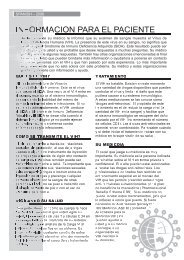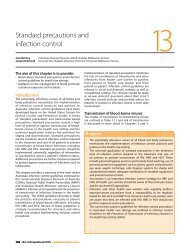HIV, HBV, HCV and STIs: similarities and differences - ASHM
HIV, HBV, HCV and STIs: similarities and differences - ASHM
HIV, HBV, HCV and STIs: similarities and differences - ASHM
Create successful ePaper yourself
Turn your PDF publications into a flip-book with our unique Google optimized e-Paper software.
1 <strong>HIV</strong>, <strong>HBV</strong>, <strong>HCV</strong> <strong>and</strong> <strong>STIs</strong>: <strong>similarities</strong> <strong>and</strong> <strong>differences</strong><br />
Key points<br />
Continued from page 9<br />
• <strong>HCV</strong> is transmitted primarily through blood-to-blood contact. The<br />
sharing of equipment during injecting drug use is the most common<br />
mode of transmission in Australia. A minority of people clear <strong>HCV</strong><br />
from the body but the majority develop a chronic infection. Some<br />
chronically infected individuals will develop symptoms such as<br />
fatigue <strong>and</strong> nausea. A small proportion of individuals will progress<br />
to liver failure or hepatocellular carcinoma. Combination therapy<br />
may be effective, although <strong>HCV</strong> genotype significantly influences<br />
response to treatment.<br />
• Early diagnosis <strong>and</strong> treatment of non-viral <strong>STIs</strong> is an effective<br />
intervention for the population control of <strong>STIs</strong> generally, while<br />
suppressive anti-viral therapy for genital herpes decreases onward<br />
transmission of this virus <strong>and</strong> may indirectly assist in reducing the<br />
spread of <strong>HIV</strong>.<br />
This chapter describes the blood-borne viral <strong>and</strong><br />
sexually transmitted micro-organisms, specifically<br />
focusing on their biology, transmission, pathogenesis<br />
<strong>and</strong> natural history. It also provides an introduction<br />
to the principles of therapy <strong>and</strong> discusses the effects<br />
of therapy on the natural history of each of these<br />
infections. This chapter will discuss only the following<br />
<strong>STIs</strong> as representative of the group as a whole. These<br />
six infections are included because of their serious<br />
long-term sequelae or because they are common in<br />
Australia <strong>and</strong> New Zeal<strong>and</strong>:<br />
• Genital chlamydial infection (including<br />
lymphogranuloma venereum [LGV])<br />
• Genital herpes (herpes simplex virus, or HSV)<br />
• Genital warts (human papillomavirus, HPV)<br />
• Gonorrhoea (Neisseria gonorrhoeae)<br />
• Syphilis (Treponema pallidum)<br />
• Trichomoniasis (Trichomonas vaginalis)<br />
In addition, there will be a brief discussion about<br />
bacterial vaginosis because it is very common.<br />
Bacterial vaginosis may not be a true STI as it can occur<br />
in celibate women on rare occasions <strong>and</strong> treating the<br />
sexual partners of women with bacterial vaginosis<br />
has no effect on recurrence rates in index patients.<br />
Biology<br />
(virology <strong>and</strong> microbiology)<br />
<strong>HIV</strong><br />
The manifestations of <strong>HIV</strong> were first apparent in<br />
the early 1980s when an epidemic of unexplained<br />
cases of immunodeficiency was reported in the<br />
western world. Evidence suggested the cause to be<br />
a transmissible agent, <strong>and</strong> in 1984 the agent was<br />
confirmed to be a retrovirus now known as human<br />
immunodeficiency virus (<strong>HIV</strong>). Human infection may<br />
date back to the early part of the twentieth century<br />
<strong>and</strong> the virus may have originally been transmitted<br />
zoonotically to humans from primates in Africa.<br />
12 <strong>HIV</strong>, viral hepatitis <strong>and</strong> <strong>STIs</strong>: a guide for primary care<br />
<strong>HIV</strong> is a single-str<strong>and</strong>ed ribonucleic<br />
acid (RNA) virus. It has an outer<br />
envelope that surrounds two copies<br />
of single-str<strong>and</strong>ed RNA as well as<br />
a number of viral proteins. From<br />
its outer envelope protrudes the<br />
120 glycoprotein (gp 120). The<br />
<strong>HIV</strong> replication cycle commences<br />
when gp 120 attaches to the CD4<br />
receptor <strong>and</strong> the chemokine coreceptor<br />
CCR5. (These receptors<br />
are expressed on the surface<br />
of the CD4 lymphocyte, the<br />
cell that <strong>HIV</strong> predominantly<br />
infects.) Attachment precipitates<br />
the fusion of the membranes<br />
of virus <strong>and</strong> cell via the <strong>HIV</strong><br />
envelope 41 glycoprotein (gp<br />
41), allowing the virus to enter<br />
the cell. The RNA then undergoes<br />
reverse transcription, a process<br />
whereby RNA is converted to<br />
deoxyribonucleic acid, (DNA)<br />
using the viral-encoded reverse transcriptase. The<br />
resulting viral DNA, called the provirus, migrates to the<br />
nucleus <strong>and</strong> integrates into the host chromosome.<br />
The provirus acts as a template to allow production of<br />
messenger RNA to produce the components of new<br />
virus particles, including the RNA genome of new<br />
virions. The viral proteins are processed <strong>and</strong> cleaved<br />
by another virus-specific enzyme known as <strong>HIV</strong><br />
protease. Viral proteins <strong>and</strong> RNA are then assembled<br />
<strong>and</strong> bud from the cell membrane, forming mature<br />
<strong>HIV</strong> particles that can infect other cells. Some of the<br />
CD4 cells are irreparably damaged by <strong>HIV</strong> infection.<br />
Premature cell death of damaged CD4 cells in part<br />
contributes to the immunosuppression characteristic<br />
of advanced <strong>HIV</strong> disease. 2<br />
<strong>HBV</strong><br />
<strong>HBV</strong> is a non-cytopathic virus <strong>and</strong> contains a<br />
partially double-str<strong>and</strong>ed DNA genome. This virus<br />
predominantly infects hepatocytes <strong>and</strong> belongs to<br />
the hepadnavirus family. <strong>HBV</strong> has an outer envelope<br />
containing hepatitis B surface antigen (HBsAg) <strong>and</strong><br />
a core containing hepatitis B core antigen (HBcAg).<br />
Excess HBsAg is produced as sub-viral particles<br />
which circulate in the blood <strong>and</strong> permit serological<br />
diagnosis of <strong>HBV</strong>. The core contains the genomic<br />
DNA as well as the viral-encoded DNA polymerase,<br />
which is detected in liver tissue. <strong>HBV</strong> also produces<br />
hepatitis B 'e' antigen or HBeAg, which is secreted<br />
into the blood <strong>and</strong> is detected by serological assay.<br />
The presence of circulating HBeAg <strong>and</strong> serum <strong>HBV</strong><br />
DNA is indicative of ongoing viral replication <strong>and</strong><br />
increased infectivity. Resolution of <strong>HBV</strong> infection is<br />
accompanied by clearance of HBeAg <strong>and</strong> HBsAg <strong>and</strong><br />
seroconversion to anti-HBe-positivity (anti-HBe+) <strong>and</strong><br />
anti-HBs-positivity (anti-HBs+).






